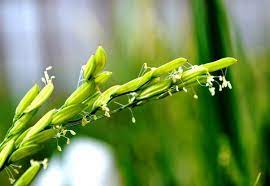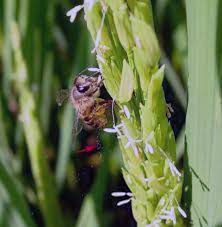Rice anther is a crucial part of the reproductive structure of the rice plant (Oryza sativa), which is a staple food crop widely cultivated around the world. Anthers are the male reproductive organs found within the flowers of flowering plants, and they produce pollen grains containing the male gametes (sperm cells) necessary for fertilization.
A rice anther is a small, oval-shaped structure located at the tip of a slender filament called a stamen. Each flower typically contains multiple stamens, each with its own anther. The anther consists of several layers of cells, each with specific functions.
The outermost layer of the anther is called the epidermis. It serves as a protective barrier and helps prevent moisture loss. Beneath the epidermis is a layer of cells known as the endothecium. These cells play a role in anther dehiscence, which is the process by which the anther opens to release pollen.
The middle layers of the anther are involved in the development of pollen grains. These layers undergo various stages of cell division and differentiation, ultimately producing the pollen sacs or microsporangia.The tapetum is a specialized layer of cells located closest to the pollen sacs. It provides nourishment to developing pollen grains and plays a vital role in their maturation.
The primary function of a rice anther is the production and release of pollen grains. Pollen grains are the male reproductive cells that are transferred from the anther to the stigma of the same or a different rice flower, leading to fertilization. Fertilization is a crucial step in the formation of rice seeds, which are eventually harvested for consumption or cultivation.
Rice anther plays a vital role in the reproduction of the rice plant by producing and releasing pollen, which is essential for the successful development of rice seeds.
The Economic Importance and Uses of Rice Anther

Let’s explore the economic importance and uses of rice anthers in rice cultivation and breeding:
1. Plant Breeding and Hybridization: Rice anthers are essential in the process of developing new rice varieties through hybridization. Plant breeders use the anthers to create hybrids with desired traits, such as higher yield, disease resistance, and improved nutritional content. Anthers are carefully collected and used to pollinate other rice plants, leading to the development of hybrid seeds.
2. Varietal Improvement: Anther culture techniques are employed in biotechnology laboratories to induce and develop genetic variations, which can then be used to create improved rice varieties. These improved varieties may exhibit traits like higher yield, better quality, and resistance to pests and diseases.
3. Stress Tolerance and Climate Adaptation: By studying rice anthers and their responses to various environmental stresses (such as drought, salinity, and extreme temperatures), researchers can develop rice varieties that are more resilient and adaptable to changing climatic conditions. This is crucial for ensuring stable rice production in the face of climate change.
4. Genetic Engineering and Biotechnology: Rice anthers are used in genetic engineering and biotechnology research to introduce specific genes into the plant’s genome. This can lead to the development of genetically modified rice varieties with enhanced traits, such as increased nutritional value or tolerance to specific herbicides.
5. Seed Production and Distribution: Rice anthers are used in controlled breeding programs to produce hybrid rice seeds. These hybrid seeds are then distributed to farmers for cultivation. Hybrid rice varieties often exhibit improved yield potential and other desirable characteristics, contributing to higher agricultural productivity and economic benefits.
6. Research and Development: Rice anthers are essential for basic research on plant genetics, reproductive biology, and crop improvement. Understanding the mechanisms involved in anther development, pollen formation, and pollination can lead to insights that benefit rice cultivation practices and enhance yield and quality.
Read Also: Rice Stigma: Economic Importance, Uses and By-Products
7. Disease Resistance and Pest Management: Researchers utilize rice anthers to study the genetic basis of disease resistance and pest tolerance in rice plants. By identifying and manipulating specific genes within the anthers, scientists can develop rice varieties that are less susceptible to pests and diseases. This can lead to reduced reliance on chemical pesticides, resulting in cost savings for farmers and improved environmental sustainability.
8. Seed Industry and Commercialization: The use of rice anthers in hybrid rice seed production has spurred the growth of the seed industry. Companies involved in rice breeding and seed production develop and market hybrid rice varieties with enhanced traits. This industry contributes to economic growth, as farmers invest in improved seeds to increase their crop yields and overall profitability.
9. Export and Trade: Rice is a globally traded commodity, and the development of high-yielding and high-quality rice varieties through anther culture and breeding programs can enhance a country’s competitiveness in the international rice market. Improved rice varieties can lead to higher export potential and generate foreign exchange earnings.
10. Food Security and Livelihoods: Rice is a staple food for millions of people worldwide, particularly in Asia. By improving rice varieties through the use of rice anthers, countries can enhance food security and contribute to poverty reduction. Increased rice production and productivity can support livelihoods in rural areas where rice cultivation is a primary economic activity.
11. Value-Added Products: Research on rice anthers can lead to the development of value-added rice products, such as fortified rice with enhanced nutritional content. Through genetic modification or traditional breeding techniques, rice varieties can be engineered to have higher levels of vitamins, minerals, and other nutrients, addressing malnutrition and improving public health.
12. Research Collaboration and Knowledge Sharing: The study of rice anthers fosters international collaboration and knowledge sharing among researchers, agronomists, and plant breeders. This collaborative effort contributes to the dissemination of best practices, innovative techniques, and scientific advancements, all of which can lead to more efficient and sustainable rice production systems.
13. Capacity Building and Training: The cultivation and research involving rice anthers provide opportunities for education and training in the fields of agriculture, biotechnology, and plant sciences. This helps build local expertise and empowers farmers, researchers, and technicians to contribute to the ongoing improvement of rice cultivation practices.
The Products and By-products That Can Be Derived From Rice Anther

Rice anther is a part of the rice flower that contains pollen grains. It has potential applications in various fields due to its unique composition.
Here are some products and by-products that can be derived from rice anther, along with explanations, examples, and processes:
1. Pollen Grains for Plant Breeding: Pollen grains from rice anthers can be collected and used in plant breeding programs to create new rice varieties with desired traits, such as disease resistance, improved yield, or stress tolerance. This process involves cross-pollinating different rice plants to produce hybrid seeds. Developing a new rice variety that is more resistant to a specific disease by cross-pollinating an anther containing disease-resistant pollen with a target rice plant.
2. Pollen Allergen Extracts: Rice pollen allergen extracts can be prepared from rice anthers for diagnostic and therapeutic purposes, such as allergy testing and treatment. These extracts can help diagnose pollen allergies and be used for immunotherapy. Preparing an allergen extract from rice pollen anthers to diagnose and treat individuals with rice pollen allergies.
3. Bioactive Compounds: Rice anthers contain bioactive compounds, such as flavonoids, phenolic acids, and antioxidants. These compounds have potential health benefits and can be extracted for use in dietary supplements or functional foods.
4. Cosmetic Ingredients: Bioactive compounds from rice anthers can also be used in cosmetic products for their skin benefits, such as anti-aging, anti-inflammatory, and moisturizing properties. Incorporating rice anther extracts into a facial cream to provide anti-aging effects.
5. Natural Dyes: Pigments present in rice anthers can be extracted and used as natural dyes for textiles, clothing, and other materials. Extracting pigments from rice anthers to create a natural dye for coloring fabric.
Read Also: Rice Pollen: Economic Importance, Uses and By-Products
6. Medicinal Uses: Rice anthers have been used in traditional medicine for various purposes, such as improving digestion, reducing inflammation, and treating fever.
7. Plant Hormone Production: Plant hormones like auxins and gibberellins can be extracted from rice anthers and used in agricultural practices to stimulate plant growth and development. Extracting gibberellins from rice anthers to enhance the growth of other crops.
8. Biofuel Production: Rice anthers contain lipids that can be converted into biofuels through processes such as transesterification to produce biodiesel. Converting lipids from rice anthers into biodiesel for use as a renewable energy source.
9. Nutritional Supplements for Livestock: Rice anther extracts can be used as nutritional supplements for livestock to improve their health and productivity. Adding rice anther extracts to animal feed to enhance the growth and health of poultry.
10. Pharmaceutical Compounds: Compounds present in rice anthers could have potential pharmaceutical applications, such as antiviral, antibacterial, or anti-inflammatory agents. These compounds can be extracted and further developed for medicinal purposes.
11. Biodegradable Packaging Materials: The cellulose and lignin present in rice anthers can be used to create biodegradable packaging materials, reducing plastic waste and environmental impact. Developing biodegradable food packaging using rice anther-derived materials.
12. Natural Pesticides: Extracts from rice anthers may contain compounds with pesticidal properties, which could be developed into natural alternatives to synthetic pesticides.
13. Fertilizer Enhancers: Extracts from rice anthers could potentially enhance the nutrient uptake and growth of plants when used as a supplement to fertilizers. Formulating a plant growth enhancer using rice anther extracts to improve nutrient absorption.
14. Bioremediation: Certain compounds from rice anthers might have the ability to remove pollutants from soil or water, making them useful for bioremediation processes. Using rice anther-derived compounds to remediate soil contaminated with heavy metals.
15. Flavor and Fragrance Compounds: Volatile compounds present in rice anthers can be used to create natural flavors and fragrances for the food, beverage, and cosmetic industries. Extracting aromatic compounds from rice anthers for use in perfumes or flavoring agents.
16. Plant Tissue Culture: Rice anthers can serve as a source of explants for plant tissue culture, facilitating the rapid propagation of desirable rice varieties. Initiating tissue culture from rice anthers to produce clonal plants with specific traits.
17. Animal Feed Additives: Extracts from rice anthers could be used as feed additives for livestock to enhance their health, growth, and productivity. Incorporating rice anther extracts into animal feed to improve the nutritional value for cattle.
18. Bioplastics: The starch and cellulose content in rice anthers can be utilized to produce bioplastics, which are more environmentally friendly alternatives to traditional plastics.
These potential products and by-products from rice anther illustrate the diverse applications that can arise from this part of the rice flower. However, it’s important to conduct further research, experimentation, and validation to fully understand and realize the feasibility and benefits of these applications.
In conclusion, while rice anthers themselves may not be directly used for economic purposes, their role in rice cultivation, breeding, and research has far-reaching economic implications. From increasing agricultural productivity and food security to fostering technological innovation and international collaboration, the study of rice anthers contributes to the overall well-being of communities and economies that rely on rice as a fundamental crop.
Read Also: Benefits of Studying Agricultural Economics
